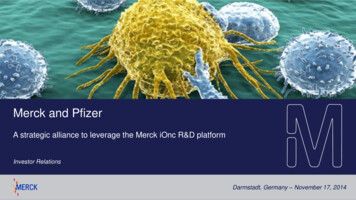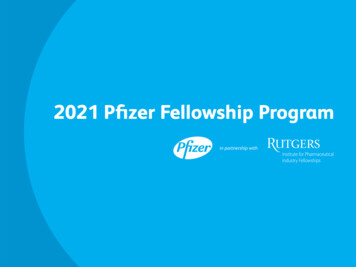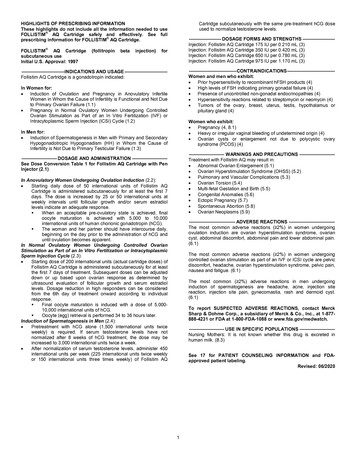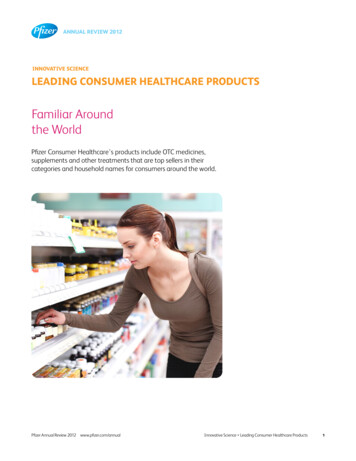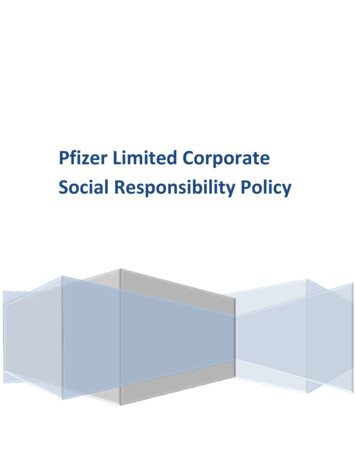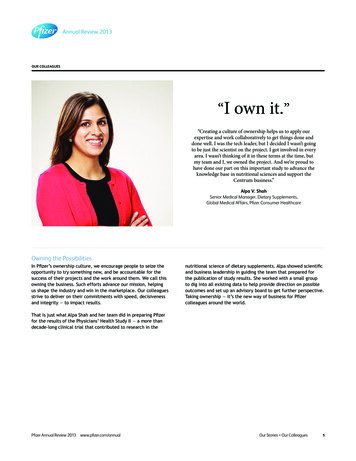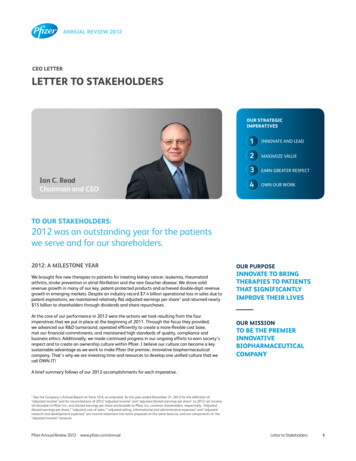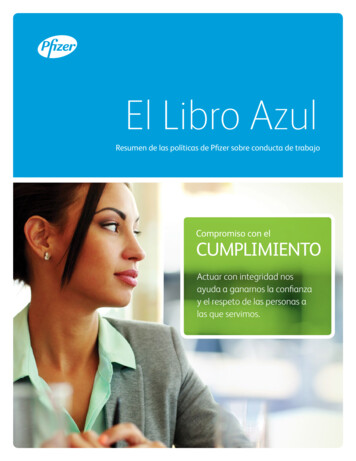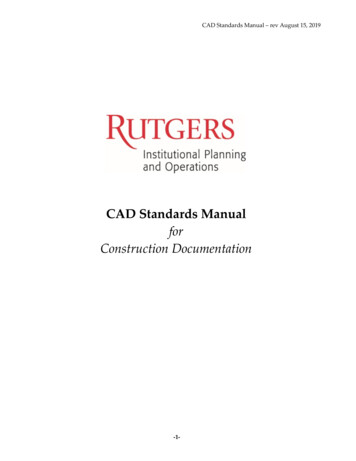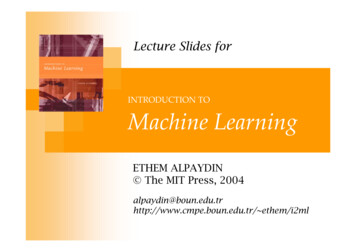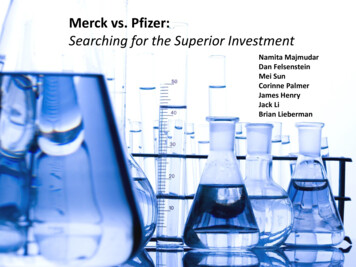
Transcription
Merck vs. Pfizer:Searching for the Superior InvestmentNamita MajmudarDan FelsensteinMei SunCorinne PalmerJames HenryJack LiBrian Lieberman
Research & Development 12 B 4 BR&D Cost 6 B(2012) 16 B 4 B10-15 Years to develop1975 - USD 138 million2014 - USD 1.5 BILLIONVery high per-Drugdevelopment costHeavily Regulated2011 - 35 newpharmaceuticals launchedout of 3,200 compounds2015 – Revenue tocontract 0.4% due to highR&D costsShifting to less lucrative orniche product segments 38 B – Phase IIIHIGH Risk HIGH Rewards
Acquisitions (Industry Consolidation) High R&D costsExpectation of fast growthKeep up with RevenuesPatent CliffAddition to productportfolioThreat from generic andbiosimilar productsDiversificationStronger positioning inexisting marketsEnter new marketsCost savings throughSynergies
About Merck Jacob Friedrick Merck acquired The Angel Pharmacy in 1668which led to the beginning of Merck & Co. Known as Merck in US and Canada Known as Merck Sharp & Dohme Corp (MSD) rest of the world Four Operating Divisions 7th largest Company in the Industry as per Revenue Ranking 2014 R&D Expense - 6.5 billion
Merck’s AcquisitionOf Schering-PloughAcquisition completed on November 3, 2009Purchase PriceCash/ Share MixFunding 49.6 Billion or 28.19 per SP common share 10.50 Cash and 0.5767 of SP shareCombination of Cash, Debt and EquityOwnershipOld Merck - Merck Sharp & DohmeSchering-Plough – Merck & Co. Inc.Products addedPfizer originally 27 in phase III whichincreased to 34 after merger
About Pfizer Founded in 1849 and has been in the industrymore than 150 years. Largest Biopharmaceutical Company (Giant) Nine principal operating divisions 4th largest Company in the Industry as per Revenue Ranking History of Acquisitions
Pfizer’s Acquisition of Wyeth Acquisition completed on October 15, 2009Purchase Price 68.2 Billion or 50.40 per Wyeth CSCash/ Share Mix 33.00 Cash and 0.985 of Pfizer shareFundingCombination of Cash, Debt and EquityOwnershipWyeth – Wholly owned SubsidiaryPfizer – approx. 84% rest minority S/HProducts addedPfizer originally 27 in phase III whichincreased to 34 after merger
Pfizer’s Acquisition of WyethPfizer’s Strategic Goals Advanced by Wyeth mergerStrong PositioningIncreased Product portfolioNew and ExistingMarketsEnters the new Vaccines market – PrevnarLeader in Biologics - EnbrelComplementaryBusinessAdded Consumer and Nutritional divisionsStrengthen Animal Health divisionFinancial BenefitsEPS Growth outpaced Revenue GrowthsAdj. Income and Diluted EPS IncreasedCost SavingsExpected savings due to synergies andcombined workforce up to 4.0 B by 2012Merger delivered Value to Shareholders and Stakeholders
Areas of Analysis:1. Pipeline Showdown2. Research & Development(accounting focused)3. Regulatory ComplianceConclusion:Final Investment Decision
PIPELINE
Breakdown1. Areas of Focus/Specialties2. Current Products3. Future Products/Drug Pipeline
Areas of Focus Primary Care (Diabetes, Cardiovascular) Women’s Health Hospital and Specialty (Hepatitis, HIV, AcuteCare, Immunology) Vaccines
Ebola Vaccine April 2015: Merck’s Ebolavaccine entered Phase IIItesting in Sierra Leone Shown to be 100%effective in preventing Ebola,according to an interim lookfrom a late-stage study "Our motivation to pursue this opportunity was to addressa public health need," Merck Vaccines' Mark Feinberg saidin a telephone interview. "We did not believe this was acommercial opportunity."
Top Selling Products
Patent Protection “The Company depends upon patents to provide it withexclusive marketing rights for its products for someperiod of time. Loss of patent protection for one of theCompany’s products typically leads to a significant andrapid loss of sales for that product, as lower pricedgeneric versions of the drug become available” Singulair patent expired in 2012– 2011 Sales: 5.5 billion– 2012 Sales: 1.34 billion
Januvia Treats Type-2 Diabetes Introduced in 2006 Low side effects and easy to use Past three years: Over 12 billion in revenue– 2014 Sales: 3.93 billion Patent protection until 2022
Remicade Treats chronic inflammatory diseases Costs between 19,000 and 22,000per year– 2014: 2.372 billion– 2013: 2.271 billion– 2012: 2.076 billion Marketing rights in Eastern Europe, Russiaand Turkey Patents have expired or set to soon– 10% decline in sales for the fourth quarter of 2014
Pipeline Phase I: Testing on a small number of healthyhuman volunteers in order to find any possibleside effects– Emphasis Safety Phase II: Testing on a larger number of humanswho are suffering from the illness– Emphasis Effectiveness Phase III: Larger scale. Tested on differentpopulations, in different dosages and incombinations with other drugs Under Review
Keytruda Under review by theEuropean MedicinesAgency for the treatmentof advanced melanoma Keytruda clinical development program alsoincludes studies in more than 30 cancersincluding: bladder, colorectal, gastric, head andneck, non-small-cell lung, among others Received priority-review status from the FDA fornon-small-cell lung cancer
Keytruda September 2014: FDA approved Keytruda at a dose of2mg/kg every three weeks for the treatment ofpatients with certain types of melanoma Cost patients around 12,500 a month Projected to reach 5billion in annual revenues once fully approved Patent protection until 2028
Reasons to be Optimistic Efficient in responses to emerging medical issues Top products under patent protection– Except Remicade Pipeline is extremely promising Roger Perlmutter Revenue declining– 2014: 42.237 billion– 2013: 44.033 billion– 2012: 47.267 billion
Pfizer pipelinePfizer is divided into 2 main businesses:1. Innovative Products (divided into 2 sectors) Global Innovative Pharmaceutical segment (GIP) Global Vaccines, Oncology and Consumer Healthcaresegment (VOC) Very specialized fields of medicine2. Established ProductsMostly, the popular drugs we know, thatcater to more traditional problems, likehigh cholesterol
Pfizer pipeline of April 28.2015
Oncology is crucial area:Futuresuccess ofmajorcancerdrugpartiallyattributedto Merck*
Top 50 pharmaceutical products by global sales:
Top 50 pharmaceutical products by global sales:A joint projectwith Amgen andTakeda (how muchof this number isbeing shared withthe other twocompanies?)
Top 50 pharmaceutical products by global sales:
More Patent IssuesLipitor, once the world’s biggest selling drug –peaking at annual sales of more than 9 billionand with lifetime sales of more than 131billion – is expected to generate about 3billion in sales in 2015.” Lipitor still remainsthe highest grossing drug of all time. Of note,Lipitor’s U.S. patent expired in 2011.
Patent cliff Issues:Three top Pfizer drugs are expired:Lyrica, which expired in 2013.Celebrex, which expired in 2014.Detrol, which expired in 2012.
Patent Status, Pfizer Drug Revenue Sources201220132014
Patent Status, Merck Drug Revenue Sources201220132014
Conclusion:1. Pfizer has greaterexposure to patent cliff.2. One of Pfizer’s majorcancer drugs relies onMerck’s cancer drugKeytruda (a mix of thetwo). Pfizer will likelyhave to share the profits.
Conclusion:1. Meck’s pipeline is morefocused on drugs thatmeet emerging ANDcritical needs – likecancer, HIV, Ebola, andHep C.2. Innovation in Merckpipeline is stronger.3. LESS patent cliff risk.
Implications of R&D andAcquisition AccountingCorinne Palmer
R&D Expense Recorded on the income statement Made up of expenses from:– Internal R&D Division– Separate operating segments– Impairment Charges (In process research anddevelopment) Up front and Milestone Payments– Partnerships– Licensing Agreements
R&D through M&AAcquisition Price 3.9 billionAsset is reclassifiedto an individualproduct or productrights (folded intointangible)Record IPR&D Asset of 3.2 billiona Balance Sheet item(Indefinite life intangibleasset, subject toimpairment)Once drug is approved,becomes definite lifeasset, amortizedaccordingly
R&D Expense- 7.2 billionR&D Expense- 8.4 billionIn Process R&D- 4.3 billionIn Process R&D- 387 millionIPR&D Impairment- 49 millionIPR&D Impairment- 190 millionWhy such a big difference?
R&D Expense 7.2 billion Merck Research Laboratories- Main R&D division 3.7 incurred directly by Merck Research Labs 2.8 billion- costs incurred by divisions that supportR&Do Includes depreciation, production and G&A activities, andlicensing activity 8.4 billionPfizer Worldwide R&D- different research units- 4.5billionR&D Transferred to 3 segments when proof of conceptachievedGlobal Innovative Pharmaceutical- 1.6 billionGlobal vaccines, oncology, and consumer healthcare 925 millionGlobal established Pharmaceutical - 657 millionUp front and milestone payments- 1.4 billion
In Process Research and Development“Pipeline programs measured at fair value andcapitalized in connection with mergers andacquisitions.” -Pfizer 10KMerck- 4.3 billionPfizer- 387 millionMerck IPR&DPfizer IPR&DMK-3862 (14) 3.2 billionInnoPharma (14) 212 millionBridion (13) 200 millionNext Wave (12) 45 million
IPR&D Impairment Recorded as part of R&Dexpense Occurs when drugs do notreach profitability orapproval Usually full write offs ofIPR&D assetsTotal 528 millionTotal 810 millionMerck201220132014IPR&D Gross Carrying Balance2,3931,8564,345IPR&D Impairment20027949IPR&D Impairment Charge as a% of IPR&D Carrying Balance8.4%15.0%1.1%IPR&D Gross Carrying Balance6881,856387IPR&D Impairment39322719057.1%12.2%49.1%PfizerIPR&D Impairment Charge as a% of IPR&D Carrying Balance
In Conclusion Merck has a more stable and consistent R&DExpense Merck has demonstrated greater success inacquisitions of IPR&D.– Quality of drugs in IPR&D– Acquiring drugs that stuck with Merck’s mission– Lower IPR&D impairment costs
Common types violations in big pharma– Off-Label promotion– The FDA approves only specific uses for drugs, any otheruse may not be marketed– Doctors have discretion to prescribe other uses for meds,but companies cannot “educate” or try to sell the otheruses to doctors– Kickbacks– For decades big pharmaceutical companies have beenpaying the doctors who prescribe their medicine the most– Companies create elaborate and hard to trace paymentmethods that make kickbacks very hard to track For example: Speaking engagements– Highly illegal and very dangerous for the general public,we don’t want to be prescribed medicine we don’t need!– Bribery– The FCPA was created to lengthen the reach of the UnitedStates government to try to tackle bribery– It is against FCPA regulations to bribe any foreign official– Pervasive and hard to catch
2009 - 2.3 Billion dollar settlement for violationsrelate to Off-Label Promotion» “the largest health care fraud settlement in the history of theDepartment of Justice” - United States Department of Justice» Pervasive sales and marketing scheme to try to get doctorsto promote 13 different drugs for off label uses.» Sales teams were incentivized to use such sales schemes» Largest health care fraud settlement in history of US DOJ 2011- 14.5 Million dollar settlement for OffLabel Promotion 2012 - 45 Million to SEC and 15 Million to DOJfor FCPA Violations for bribery» Violations spanned across 8 countries
2011- 950 million For Off-Label Promotion– Pervasive and organization wide violations– Used “tutorial program“ which was really just a way to promoteOff-Label 2015 - 5.9 Million Civil violations related to OffLabel Promotion– Off-Label promotion by firm that was acquired by Merck,violations occurred before Merck’s acquisition 2015 – No fine or settlement stemming from DOJprobe
VSPfizerMerckViolationSettlement & Fines2009 – FCA violations related tooff-label promotion 2.3 billion2011 – FCA violations related tooff-label promotion 950 million2011 – FCA violations related tooff-label promotion 14.5 million2015 – civil violations related tooff-label promotion 5.9 million2012 – FCPA violations (SECcomplaint) 45 million2012 – FCPA violation (DOJcomplaint) 15 millionTotal (approx.) 2,374,500,000Violation2010 – 2014 DOJ FCPA probeSettlement & FinesNo fines/settlement 955,900,000
Merck’s Advanced Analytics In 2010, Merck started usingadvanced analytics in their internalaudit efforts These efforts have been expandingin the past 5 years Even though we can not be totallysure if the advanced analytics arethe reason that they have not seena pattern of FCA/FCPA violations,we can safely assume that it isplaying some part
Summing up Pfizer and Merck both have a history of violations Pfizer has shown more of a pattern of violationscompared to Merck Merck’s utilization of advanced analytics are promising Based on regulatory compliance considerations, wewould feel that an investment in Pfizer poses a largerisk An investment is Merck poses some compliance risk,but that is somewhat mitigated by technologicaladvances in auditing practices and lack of a pattern ofviolations
FINAL EVALUATION: MERCK vs. PFIZER Merck’s Development of Keytruda– An oncology drug that stimulates the body to useits own processes to battle cancer Patent Cliff risks– Drugs that contribute 40% - 50% of Merck’sannual revenue ( 2012 – 2014) will not losepatent exclusivity for at least 5 years.– Drugs that contribute 70% of Pfizer’s annualrevenue have already lost patent exclusivity. R&D Expense– Merck spends less, acquisition focused on keyexpansion areas, eg, cancer, Hepatitis C, drugresistant -to-kno.aspx
Comparison of Merck and Pfizer’s P/E Ratio40353025MRK20PFE15105020112012201320142015
Market Data on Free Cash Flows & DividendPFEMRKFCF ( billion)DividendsDiv. As a % FCF ( of FCFbillion)DividendsD
Pfizer pipeline Pfizer is divided into 2 main businesses: 1. Innovative Products (divided into 2 sectors) Global Innovative Pharmaceutical segment (GIP) Global Vaccines, Oncology and Consumer Healthcare segment (VOC) Very specialized fields of medicine 2. Established Products Mostly,
